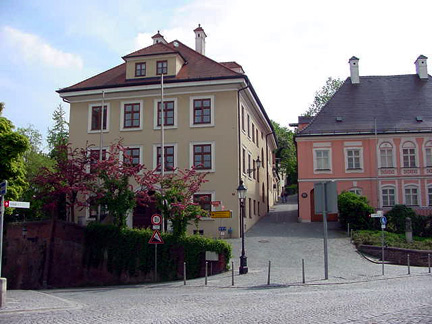District Administration Building The beautiful building on the left in the photograph above has been owned by the County Seat of Dachau since 1983; it now houses various government offices. This building's historical significance relates to the take-over of the town on March 9, 1933 when the Nazis seized control of all the state and local governments in Germany after gaining control of the federal government by winning a majority in Germany's last Congressional election on May 5, 1933. SA and SS troops marched into Dachau and hoisted the party flag of the Nazis with its swastika emblem over the District Administration Building and the nearby Old Town Hall, which is behind the camera in this photograph. The Nazi take-over of Dachau was the culmination of a chain of events that began with a fire on the night of February 27, 1933 which burned the Congressional building, called the Reichstag. The day after the fire, a "Decree of the Reich President for the Protection of the People and State" was announced by German President Paul von Hindenberg. This document suspended the seven sections of the Weimar Constitution which guaranteed the civil rights of the German people. The decree also ended state's rights with the statement that "if in any German state, the measures necessary for the restoration of public security and order are not taken, the Reich government may temporarily take over the powers of the supreme authority in such a state in order to restore security." Although intended to be an emergency measure, the decree was never rescinded. Following the Reichstag fire, Communist members of the legislature were arrested as suspected terrorists and sent to Landsberg prison near Munich. With the help of the Nationalist party, the Nazis won 340 Congressional seats out of a total of 647 in the last election on March 5th, giving them control over the federal government. During the following days, the Nazis appointed "Reich commissioners" to take over all the state and local governments under the authority of the Decree. Thus the democratic Weimar Republic was replaced by the Third Reich, as Hitler's Nazi government was called. This meant that for the first time in history, Germany was united under one strong central government in which individual states like Bavaria would no longer be independent. The man who was appointed Reich commissioner for Bavaria was Ritter von Epp. Bavarian Prime Minister Held had let it be known that he would arrest any Reich commissioner who set foot in Bavaria, but on March 9th, Ernst Röhm, the leader of the SA troops, marched into Held's office and demanded the appointment of von Epp. Held could do nothing but agree to the appointment, and temporarily fled to Switzerland. After the successful takeover of Bavaria on March 9th, Heinrich Himmler, a loyal Nazi party member and the head of Hitler's private army called the SS, was appointed the acting Chief of Police in Munich and a few days later, on March 20, 1933, he announced the opening of the Dachau concentration camp. The first prisoners were the political prisoners that had been rounded up and placed in "protective custody" following the Reichstag fire. In June, the son of Prime Minister Held was sent to the Dachau concentration camp for refusing to disclose the whereabouts of his father, who had secretly returned to Bavaria and checked into a hospital. At the bottom of the photograph above, there is what seems to be a large brick-lined crater. This is the entrance to Bergstrasse, which descends steeply down the hill called the Karlsberg. The yellow traffic sign points to Munich which is 18 kilometers south down this road. The former Münchner Tor, one of the three town gates, stood at this spot. The address of the former District Administration Building is Augsbergerstrasse 1. Opposite this building, behind the camera, is the beginning of Konrad-Adenauer-Strasse, where the Gingerbread Maker's House adjoins the New Town Hall which is next to the Old Town Hall. The pink building on the right is the home of the Dachau Regional Museum. The narrow alley between the buildings is the Schlossgasse, which leads up the hill to the Schloss (castle). Dachau's air raid sheltersBack to List of Historic PlacesBack to Table of ContentsHome |